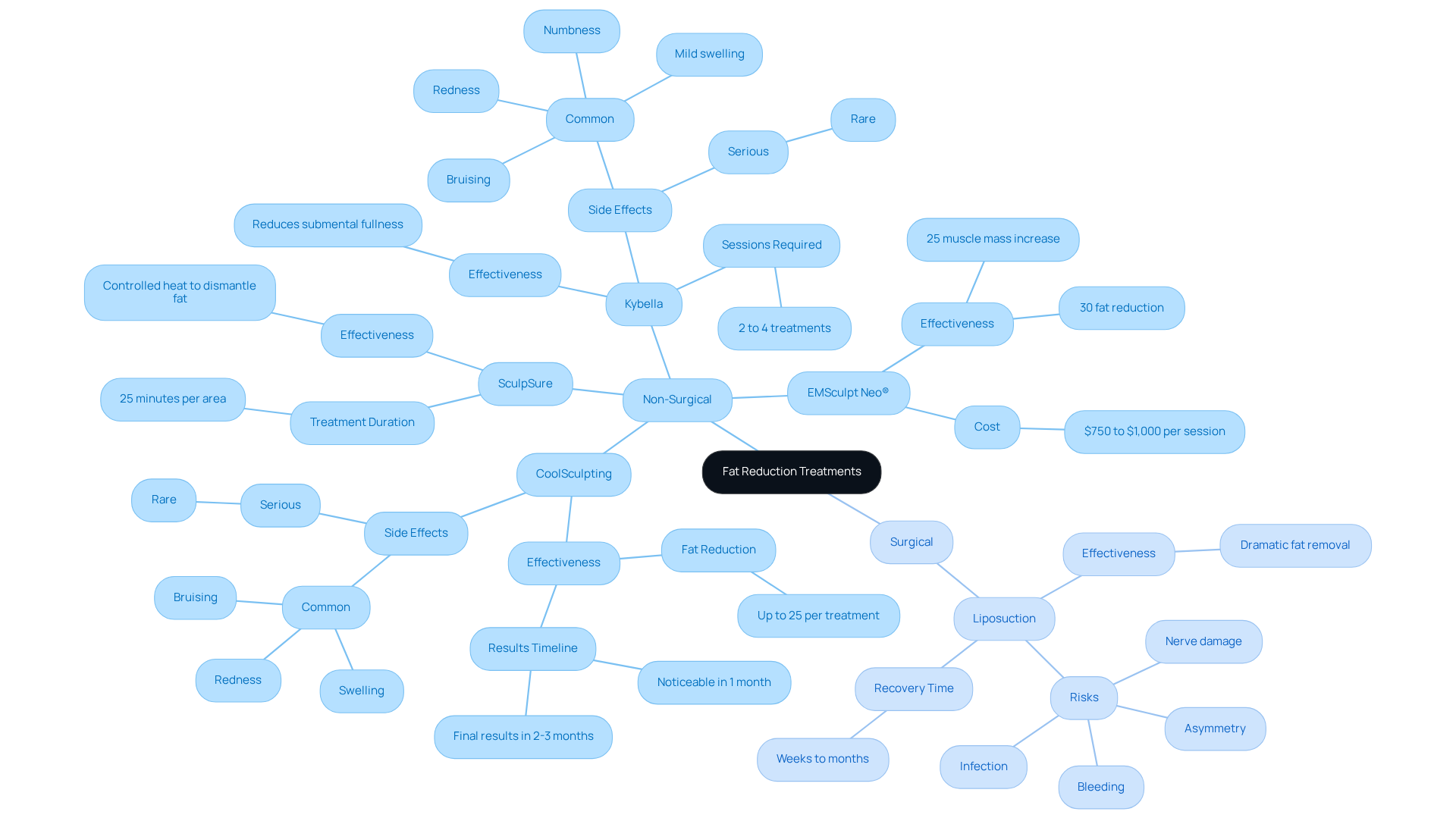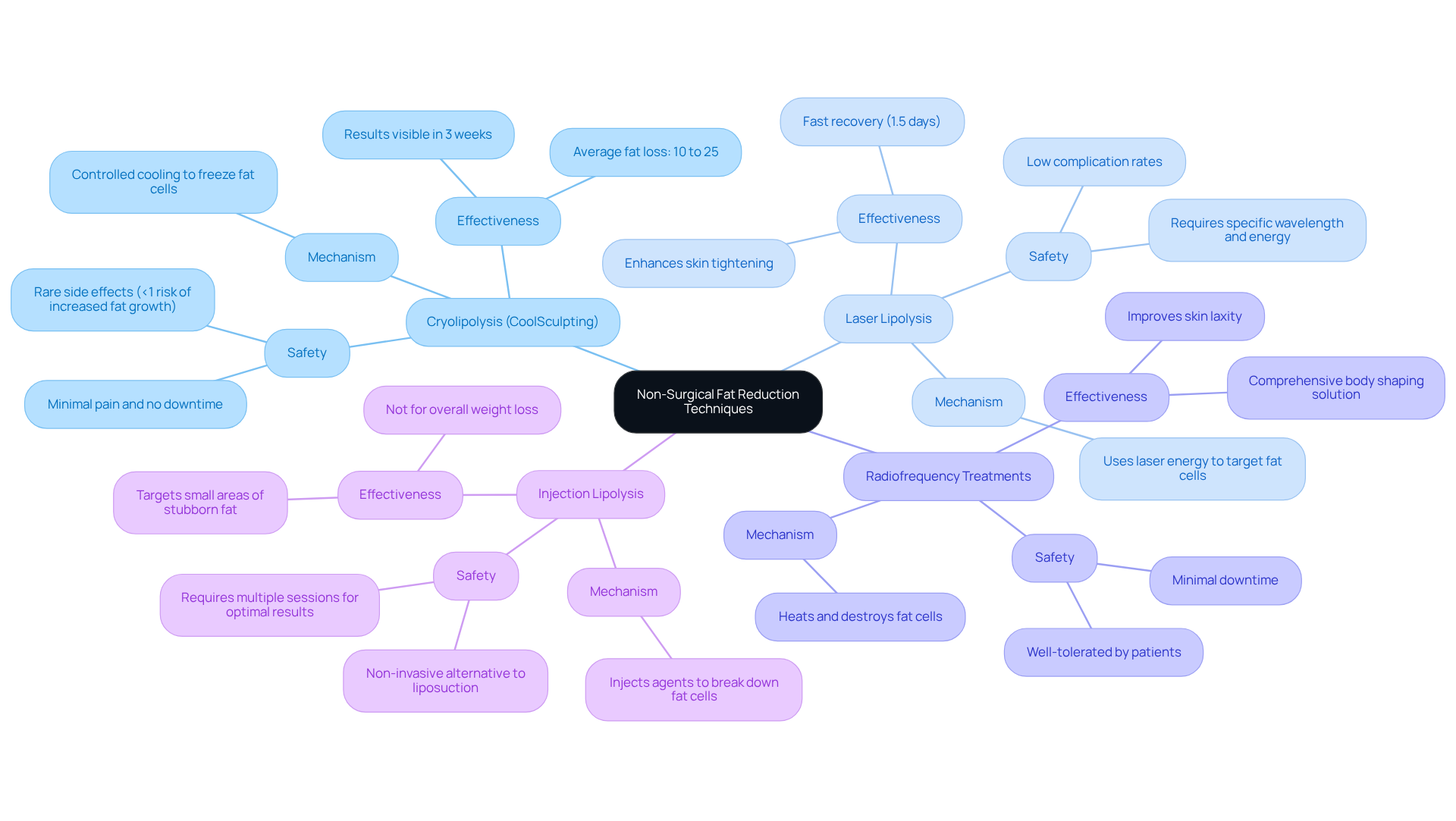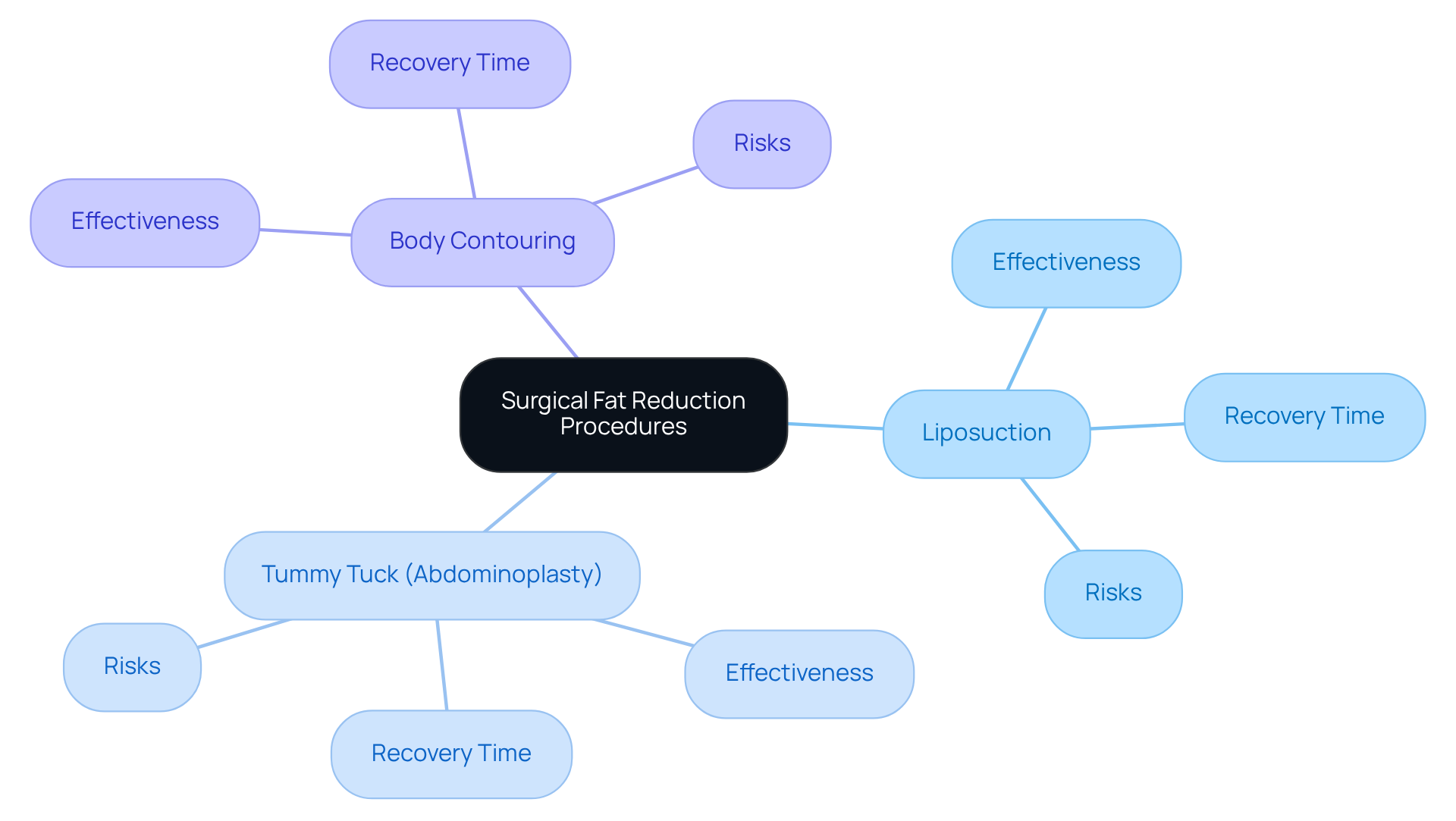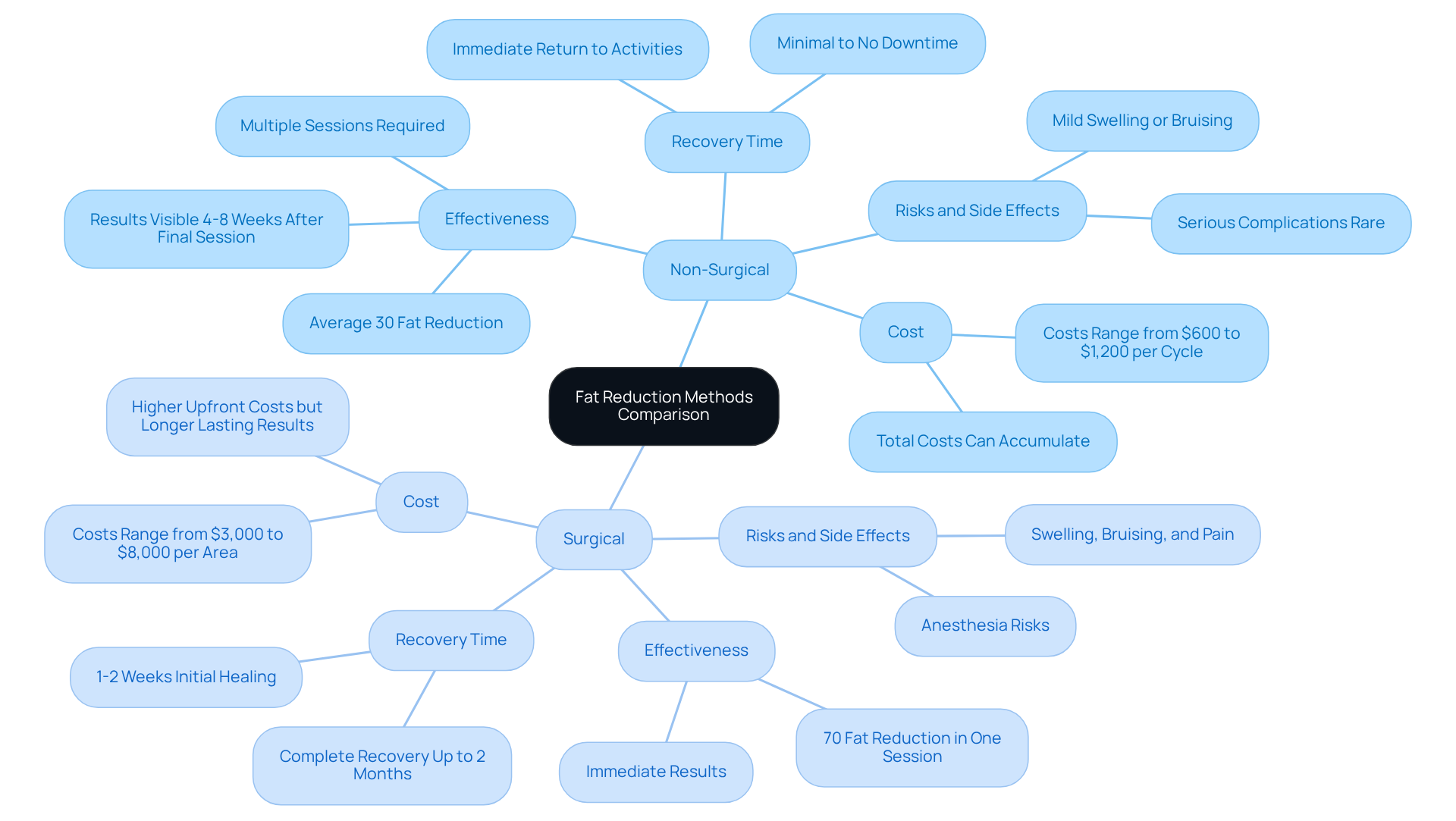Compare Non-Surgical and Surgical Options to Reduce Fat Treatment

Overview
This article provides a comprehensive comparison of non-surgical and surgical options for fat reduction treatments, emphasizing the distinct advantages and disadvantages inherent to each approach.
Non-surgical methods, such as CoolSculpting and Kybella, are characterized by minimal downtime and reduced risks, making them appealing for those seeking less invasive solutions.
Conversely, surgical options like liposuction yield more immediate and dramatic results; however, they necessitate longer recovery periods and present greater potential complications.
Ultimately, the choice between these methods hinges on individual goals and health considerations, underscoring the importance of making an informed decision.
Introduction
The pursuit of an ideal body shape has driven countless individuals to investigate various fat reduction treatments, which can be categorized into non-surgical and surgical options.
Non-surgical methods, including CoolSculpting and Kybella, have surged in popularity due to their minimal invasiveness and swift recovery times. Conversely, surgical procedures like liposuction offer more dramatic outcomes but come with increased risks and extended healing periods.
As individuals evaluate their options, a pivotal question emerges: which approach genuinely provides the best results with the least compromise?
This article explores the intricacies of both treatment types, delivering insights into their effectiveness, recovery, and potential risks, ultimately empowering readers to make informed decisions on their fat reduction journey.
Understanding Fat Reduction Treatments: An Overview
Reduce fat treatment encompasses a diverse array of methods designed to decrease body fat and enhance body contour. These treatments can be categorized into two primary groups: non-surgical and surgical alternatives.
Non-surgical techniques, such as CoolSculpting, SculpSure, and Kybella, are increasingly popular due to their minimally invasive nature and shorter recovery times. For instance, CoolSculpting can reduce fat by up to 25% per treatment, with results becoming noticeable within a month and final results visible after 2-3 months. These procedures typically require no downtime, allowing individuals to resume normal activities immediately. Common side effects of non-surgical treatments may involve swelling, bruising, and redness; however, serious side effects from Kybella are uncommon, rendering it a suitable choice for many.
In contrast, surgical options like liposuction offer more dramatic results but involve greater risks and longer recovery periods. Surgical interventions can reshape specific areas of the body by removing fat deposits, but they come with potential complications such as asymmetry, bleeding, nerve damage, and infection. Recovery from liposuction can take weeks to months, making it essential for patients to weigh the benefits against the risks.
Recent trends in fat loss highlight the growing interest in non-surgical methods, which are often viewed as safer options. Health professionals emphasize that while non-surgical options for reduce fat treatment can effectively target stubborn fat pockets, multiple sessions may be required to achieve the desired results. For example, Kybella, an injectable treatment for submental fullness, typically necessitates 2 to 4 treatments spaced a month apart for optimal outcomes. Moreover, EMSculpt Neo®, priced between $750 and $1,000 per session, focuses on regions like the abdomen, buttocks, arms, and legs, merging muscle development with fat loss.
Case studies show that numerous individuals who experience non-surgical fat loss report notable enhancements in their figure and overall contentment. Patients often experience a more defined appearance and enhanced confidence, with results lasting as long as they maintain a healthy lifestyle. As Dr. Aviva Preminger notes, understanding the differences between these options is crucial for patients seeking to contour their bodies effectively. Ultimately, the choice between should be guided by individual goals, preferences, and the advice of qualified professionals on reduce fat treatment.

Exploring Non-Surgical Fat Reduction Techniques
Non-surgical fat loss techniques encompass a range of innovative therapies specifically designed for reduce fat treatment without the need for invasive surgery. Among the most popular methods are:
- Cryolipolysis (CoolSculpting): This technique utilizes controlled cooling to freeze fat cells, resulting in their natural elimination by the body. With over eight million treatments performed globally, is esteemed for its safety and effectiveness, requiring no downtime and allowing patients to resume normal activities immediately. Studies indicate that average fat loss can range from 10% to 25% per treatment, making it a favored choice for those pursuing targeted fat reduction.
- Laser Lipolysis: By employing laser energy, this method selectively targets fat cells, facilitating their breakdown while preserving surrounding tissues. Research shows that laser lipolysis not only reduces fat but also enhances skin tightening, positioning it as a dual-action treatment. Expert Goldman emphasizes that the efficacy of laser lipolysis is contingent upon the wavelength and energy delivered during the procedure.
- Radiofrequency Treatments: These therapies utilize radio waves to heat and destroy fat cells while simultaneously tightening the skin. This technique proves particularly beneficial for areas experiencing skin laxity, thereby improving overall contouring outcomes. The combination of fat reduction and skin tightening positions radiofrequency treatments as a comprehensive solution for body shaping.
- Injection Lipolysis: This method involves the injection of agents that break down fat cells, which are subsequently processed by the body. It serves as a targeted solution for small areas of stubborn fat, providing a non-invasive alternative to liposuction. However, it is crucial to note that injection lipolysis is not intended for overall weight loss.
Each of these techniques offers distinct benefits, such as minimal recovery time and the ability to focus on specific areas, making them effective for reduce fat treatment. They are particularly suitable for individuals aiming to refine their body shape without the commitment and risks associated with surgical procedures. As the aesthetics industry evolves, these non-invasive alternatives are gaining traction, bolstered by high patient satisfaction rates and positive clinical outcomes.

Examining Surgical Fat Reduction Procedures
Surgical procedures for reduce fat treatment represent a more invasive approach and typically entail a longer recovery period compared to non-surgical methods. Among the common surgical options are:
- Liposuction: This procedure effectively removes fat deposits through suction, allowing for significant body contouring. It is particularly effective for larger areas of fat but necessitates anesthesia and involves an extended recovery time.
- Tummy Tuck (Abdominoplasty): This surgery not only eliminates excess fat but also tightens abdominal muscles, making it ideal for individuals experiencing significant weight loss or post-pregnancy changes.
- Body Contouring: Following substantial weight loss, body contouring surgeries can remove excess skin and fat, thereby enhancing body shape and appearance.
While surgical procedures can yield dramatic results in weight loss, they also come with risks; therefore, may be a safer alternative to avoid complications from anesthesia, infection, and prolonged recovery times. Consequently, these procedures are often recommended for individuals who have specific goals and are prepared for the commitment involved.

Comparative Analysis: Non-Surgical vs. Surgical Fat Reduction
When evaluating for reduce fat treatment, several critical factors warrant careful consideration.
- Effectiveness: Surgical procedures, such as liposuction, often deliver immediate and striking results, with patients typically experiencing a fat reduction of 70% or more in the targeted area after just one session. Most individuals notice significant changes post-liposuction; however, swelling may obscure the final results for up to six months. Conversely, non-surgical methods like EMSculpt Neo® and CoolSculpting generally necessitate multiple sessions—usually two to four cycles—to achieve comparable outcomes, with results becoming evident 4 to 8 weeks following the final session.
- Recovery Time: Non-surgical techniques typically involve minimal to no downtime, enabling individuals to resume their daily activities immediately. For instance, EMSculpt Neo® sessions last around 30 minutes, allowing patients to return to their normal routines right after treatment. In contrast, surgical procedures such as liposuction necessitate a recovery period of 1 to 2 weeks for initial healing, with complete recovery extending up to 2 months. This prolonged recovery can significantly impact daily life, potentially leading to lost wages or increased childcare costs for caregivers.
- Risks and Side Effects: Non-surgical methods are associated with fewer risks and side effects, generally resulting in mild swelling or bruising that resolves quickly. Common side effects of liposuction include swelling, bruising, and pain, which typically subside within two to four weeks. Surgical procedures inherently carry risks related to anesthesia and extended healing processes, including potential complications that may arise during recovery.
- Cost: Although non-surgical treatments may initially appear less expensive, costs can accumulate due to the need for multiple sessions, often ranging from $600 to $1,200 per cycle. This can lead to overall expenses that are comparable to, or even exceed, those of surgical alternatives. In contrast, surgical procedures like liposuction involve higher upfront costs, usually between $3,000 and $8,000 per area treated, but they may offer longer-lasting results without the necessity for frequent maintenance.
Ultimately, the decision between non-surgical and surgical methods for reduce fat treatment depends on individual goals, health status, and lifestyle preferences. Consulting with a qualified wellness professional can provide invaluable insights, assisting individuals in navigating these options effectively.

Conclusion
The exploration of fat reduction treatments unveils a diverse array of options, each presenting distinct advantages and considerations. Non-surgical methods, including CoolSculpting and Kybella, deliver a minimally invasive approach that resonates with many individuals aiming to refine their body contours without the extensive recovery typically associated with surgical interventions. In contrast, surgical options such as liposuction offer immediate and dramatic results, albeit with heightened risks and longer recovery periods. Ultimately, the decision between these two avenues rests on personal preferences, objectives, and the counsel of healthcare professionals.
Key insights throughout this article underscore the effectiveness, recovery times, risks, and costs linked to both non-surgical and surgical fat reduction methods. Non-surgical treatments generally present a safer profile and require less downtime, making them particularly suitable for individuals with demanding schedules. However, it is important to note that these methods often necessitate multiple sessions to achieve the desired outcomes. Surgical alternatives, while capable of delivering more pronounced results, require a greater commitment regarding recovery and potential complications. Grasping these factors is essential for individuals embarking on their fat reduction journey.
Given the wide range of available options, it is crucial for individuals to thoughtfully assess their goals and consult with qualified professionals to make well-informed decisions. The landscape of fat reduction treatments is continuously evolving, with advancements in technology and techniques paving the way for more effective and safer solutions. By embracing this knowledge, individuals empower themselves to select the most suitable approach to realize their body contouring aspirations while prioritizing their health and well-being.
Frequently Asked Questions
What are the main types of fat reduction treatments?
Fat reduction treatments are categorized into two primary groups: non-surgical and surgical alternatives.
What are some examples of non-surgical fat reduction treatments?
Examples of non-surgical treatments include CoolSculpting, SculpSure, and Kybella.
How effective is CoolSculpting?
CoolSculpting can reduce fat by up to 25% per treatment, with noticeable results within a month and final results visible after 2-3 months.
What are the recovery times associated with non-surgical fat reduction treatments?
Non-surgical treatments typically require no downtime, allowing individuals to resume normal activities immediately.
What are common side effects of non-surgical fat reduction treatments?
Common side effects may include swelling, bruising, and redness; however, serious side effects from Kybella are uncommon.
What are the risks associated with surgical fat reduction options?
Surgical options like liposuction can involve risks such as asymmetry, bleeding, nerve damage, and infection, along with longer recovery periods.
How long does recovery from liposuction take?
Recovery from liposuction can take weeks to months.
How many sessions are typically required for Kybella to achieve optimal results?
Kybella typically requires 2 to 4 treatments spaced a month apart for optimal outcomes.
What is EMSculpt Neo® and what does it focus on?
EMSculpt Neo® is a treatment priced between $750 and $1,000 per session that focuses on regions like the abdomen, buttocks, arms, and legs, combining muscle development with fat loss.
What are the benefits of non-surgical fat loss treatments according to case studies?
Many individuals report notable enhancements in their figure and overall contentment, experiencing a more defined appearance and increased confidence, with results lasting as long as they maintain a healthy lifestyle.
How should individuals decide between non-surgical and surgical fat loss options?
The choice should be guided by individual goals, preferences, and the advice of qualified professionals regarding fat reduction treatments.


